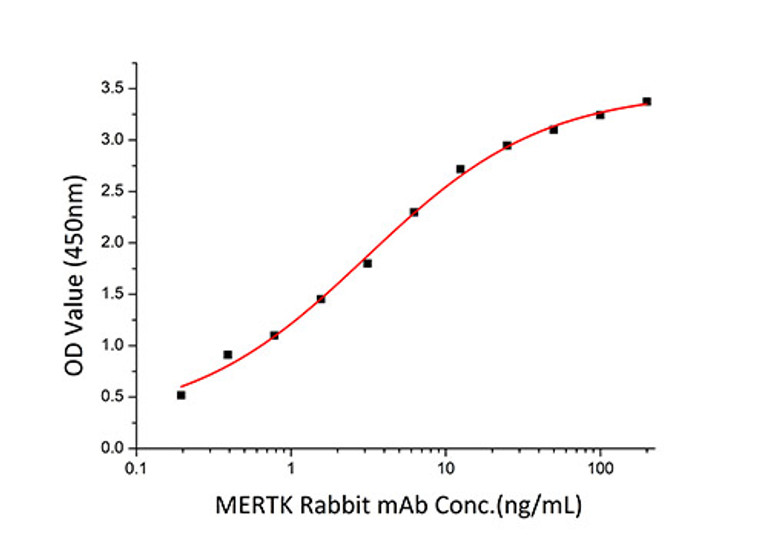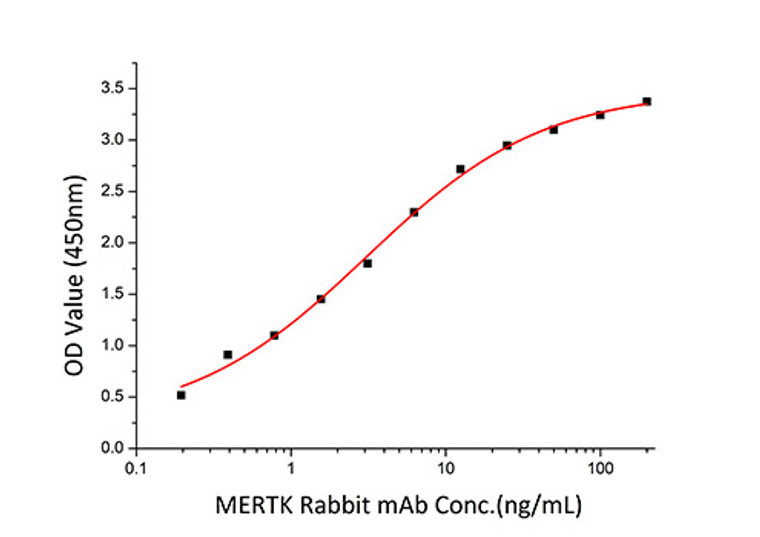| Host: |
HEK293 cells |
| Reactivity: |
Human |
| Note: |
STRICTLY FOR FURTHER SCIENTIFIC RESEARCH USE ONLY (RUO). MUST NOT TO BE USED IN DIAGNOSTIC OR THERAPEUTIC APPLICATIONS. |
| Short Description: |
Active Recombinant-Human MERTK-C-hFc&His protein was developed from hek293 cells and has a target region of C-hFc&His. For use in research applications. |
| Formulation: |
Lyophilized from a 0.22 Mu m filtered solution of PBS, pH 7.4. Contact us for customized product form or formulation. |
| Immunoreactivity: |
Measured by its binding ability in a functional ELISA. Immobilized Human MERTK at 1 Mu g/mL (100 Mu L/well) can bind MERTK Rabbit mAb with a linear range of 0.2-3 ng/mL.2. Measured by its binding ability in a functional ELISA. Immobilized Human Gas6 |
| Gene Symbol: |
MERTK |
| Gene ID: |
10461 |
| Uniprot ID: |
MERTK_HUMAN |
| Immunogen Region: |
Arg26-Ala499 |
| Immunogen: |
Recombinant Human MERTK Protein is produced by HEK293 cells expression system. The target protein is expressed with sequence (Arg26-Ala499) of human Mer/MERTK (Accession #NP_006334.2) fused with a Fc, 6×His tag at the C-terminus. |
| Tissue Specificity | Not expressed in normal B- and T-lymphocytes but is expressed in numerous neoplastic B- and T-cell lines. Highly expressed in testis, ovary, prostate, lung, and kidney, with lower expression in spleen, small intestine, colon, and liver. |
| Post Translational Modifications | Autophosphorylated on Tyr-749, Tyr-753 and Tyr-754 in the activation loop allowing full activity. Autophosphorylated on Tyr-872 leading to recruitment of downstream partners of the signaling cascade such as PLCG2. |
| Function | Receptor tyrosine kinase that transduces signals from the extracellular matrix into the cytoplasm by binding to several ligands including LGALS3, TUB, TULP1 or GAS6. Regulates many physiological processes including cell survival, migration, differentiation, and phagocytosis of apoptotic cells (efferocytosis). Ligand binding at the cell surface induces autophosphorylation of MERTK on its intracellular domain that provides docking sites for downstream signaling molecules. Following activation by ligand, interacts with GRB2 or PLCG2 and induces phosphorylation of MAPK1, MAPK2, FAK/PTK2 or RAC1. MERTK signaling plays a role in various processes such as macrophage clearance of apoptotic cells, platelet aggregation, cytoskeleton reorganization and engulfment. Functions in the retinal pigment epithelium (RPE) as a regulator of rod outer segments fragments phagocytosis. Also plays an important role in inhibition of Toll-like receptors (TLRs)-mediated innate immune response by activating STAT1, which selectively induces production of suppressors of cytokine signaling SOCS1 and SOCS3. |
| Protein Name | Tyrosine-Protein Kinase MerProto-Oncogene C-MerReceptor Tyrosine Kinase Mertk |
| Database Links | Reactome: R-HSA-202733 |
| Cellular Localisation | Cell MembraneSingle-Pass Type I Membrane Protein |
| Alternative Protein Names | Tyrosine-Protein Kinase Mer proteinProto-Oncogene C-Mer proteinReceptor Tyrosine Kinase Mertk proteinMERTK proteinMER protein |
Information sourced from Uniprot.org
12 months for antibodies. 6 months for ELISA Kits. Please see website T&Cs for further guidance











